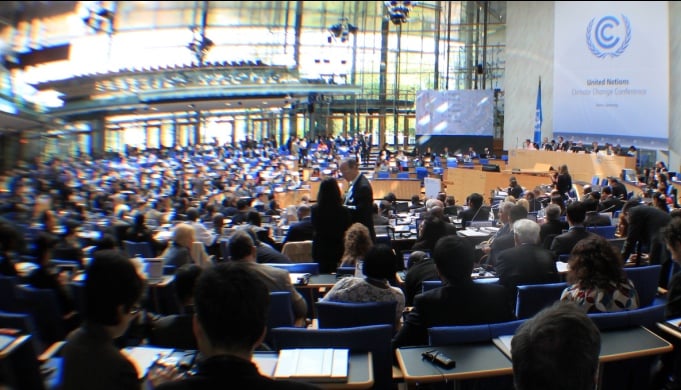Governments are not renegotiating the United Nations Framework Convention on Climate Change (UNFCCC) principles for an agreement at the Paris climate summit, says Su Wei, veteran climate negotiator from China.
The critical issues for the Paris agreement include operationalising the equity principle in the global carbon space; establishing a facilitative regime to support technology transfers; and for intended nationally determined contributions (INDCs) to go beyond mitigation to include finance, technology and capacity building support, says Ravi Prasad, senior-most climate negotiator from India.
The world has moved from the time when the UNFCCC principles were laid down, and developing countries must make their share of the sacrifice to reduce carbon emissions, say negotiators from the US, Canada, Australia, New Zealand, Japan and Russia, with European Union delegates echoing the sentiment in more muted words. The Paris agreement should be about mitigating carbon emissions, they add, and tagging on adaptation, finance and technology transfer are “unnecessary complications” in their minds.
As a crucial 10-day mid-year negotiating session for the Paris agreement opened in Bonn on June 1, the differences between developing and developed countries remain as wide as ever. Going by the experience of UNFCCC negotiations over two decades and more, the result will be grudging agreement over the lowest common denominator – leading to a weak Paris agreement that will largely fail to address the ever-worsening threat of climate change.
Independent observers are clearly worried about this. In a statement on the opening day of the Bonn meeting, Climate Action Network (CAN) – an umbrella organisation of NGOs – said, “Paris should not lock in, unacceptably and dangerously, low ambition on mitigation and finance. Periodic upward revision of ambition based on changing circumstances should be built into the text to help close the pre–2020 emissions gap. The mechanism of ratcheting up would thus help reduce the risk of locking in irreversible emission trajectories. This mechanism should not be limited to just mitigation but should be all encompassing.”
The incoming president of the Paris summit, France’s Foreign Minister Laurent Fabius, wants the deal to be ready before the summit starts on November 30, so that the last moment squabbling that has characterised previous summits can be avoided. But with no word from rich nations on the concrete steps they are taking between now and 2020 to help poor nations combat climate change, the trust deficit between the two groups of countries is too wide to be bridged right now. The Paris agreement is supposed to come into effect after 2020.
So at best, the Paris outcome will be one more step in addressing climate change, as Su Wei put it on the opening day of the Bonn meeting. He underlined the need to address both the ambition and the implementation gaps. The United Nations Environment Programme calculated last year that there was a 40% gap between the mitigation commitments of all governments and what is needed to keep average global temperature rise within two degrees Celsius.
As the negotiators start on the 90-page draft agreement with the stated purpose of reaching consensus, Fabius suggested that four pillars would underpin success in Paris:
- A universal, legally-binding agreement;
- Intended Nationally Determined Contributions (INDCs) – what each country would do;
- Finance, technology and capacity-building;
- The role and contributions of non-state actors.
India is unlikely to accept a legally-binding agreement, while rich countries are unlikely to accept being pinned down on finance, technology and capacity-building commitments. The negotiators have the unenviable job of squaring this circle.
CAN has reiterated its call for developed countries to live up to past promises, and provide a roadmap that specifies how the goal of providing $100 billion a year will be reached by 2020.
This has become even more urgent as losses from heat waves, storms, floods and droughts become more serious. The current heat wave in India has killed around 2,000 people already. Scientists have said climate change is making such extreme weather events more frequent and more severe. CAN said, “Within the 2015 agreement, (the issue of) loss and damage should be placed on equal footing with adaptation, especially since loss and damage comes into play when adaptation is no longer feasible.”
The one bit of good news is that there is huge expansion of the actions being taken by local governments and private companies worldwide, especially in the field of renewable energy. Much of that is now going into the INDCs, as shown by the 38 countries which have submitted these reports to the UNFCCC so far.
The UNFCCC secretariat also pointed out that a recent business summit in Paris “underlined the way non-state actors across the globe are already undertaking climate action, as well as rallying in support of a strong climate change agreement.” Twenty five worldwide business networks representing over 6.5 million companies from more than 130 countries pledged to help to lead the global transition to a low-emission, climate resilient economy.”
Christiana Figures, UNFCCC Executive Secretary, said, “With some 200 days to the UN climate convention conference in Paris, the growing momentum for change and for action is rapidly gaining ground across countries, companies, cities and citizens. News of yet another group of stakeholders committing to long term emission reduction targets or ambitious investments in renewable energies is emerging almost daily — building confidence and a sense of ‘can do’ among nations as we enter the final six months of 2015.” During the Bonn conference, the UNFCCC secretariat is organizing a Climate Action Fair to showcase the action that is already taking place on the ground.

